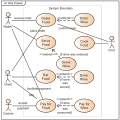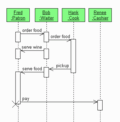- Systems Modeling Language
-
The Systems Modeling Language (SysML) is a general-purpose modeling language for systems engineering applications. It supports the specification, analysis, design, verification and validation of a broad range of systems and systems-of-systems. SysML was originally developed by an open source specification project, and includes an open source license for distribution and use.[1] SysML is defined as an extension of a subset of the Unified Modeling Language (UML) using UML's profile mechanism.
Contents
Overview
SysML offers systems engineers several noteworthy improvements over UML, which tends to be software-centric. These improvements include the following:[1]
- SysML's semantics are more flexible and expressive. SysML reduces UML's software-centric restrictions and adds two new diagram types, requirement and parametric diagrams. The former can be used for requirements engineering; the latter can be used for performance analysis and quantitative analysis. As a result of these enhancements, SysML is able to model a wide range of systems, which may include hardware, software, information, processes, personnel, and facilities.
- SysML is a smaller language that is easier to learn and apply. Since SysML removes many of UML's software-centric constructs, the overall language is smaller as measured both in diagram types and total constructs.
- SysML allocation tables support common kinds of allocations. Whereas UML provides only limited support for tabular notations, SysML furnishes flexible allocation tables that will support requirements allocation, functional allocation, and structural allocation. This capability facilitates automated verification and validation (V&V) and gap analysis.
- SysML model management constructs support models, views, and viewpoints. These constructs extend UML's capabilities and are architecturally aligned with IEEE-Std-1471-2000 (IEEE Recommended Practice for Architectural Description of Software Intensive Systems).
SysML reuses seven of UML 2's thirteen diagrams, and adds two diagrams (requirements and parametric diagrams) for a total of nine diagram types. SysML also supports allocation tables, a tabular format that can be dynamically derived from SysML allocation relationships. A table which compares SysML and UML 2 diagrams is available in the SysML FAQ.
The advantages of SysML over UML for systems engineering become obvious if you consider a concrete example, such as modeling an automotive system. With SysML you can use Requirement diagrams to efficiently capture functional, performance and interface requirements, whereas with UML you are subject to the limitations of Use Case diagrams to define high-level functional requirements. Likewise, with SysML you can use Parametric diagrams to precisely define performance and quantitative constraints such as maximum acceleration, minimum curb weight, and total air conditioning capacity. UML provides no straightforward mechanism to capture this sort of essential performance and quantitative information.
As for the rest of the automotive system, enhanced activity diagrams and state machine diagrams can be used to specify the embedded software control logic and information flows for the on-board automotive computers. Other SysML structural and behavioral diagrams can be used to model factories that build the automobiles, as well as the interfaces between the organizations that work in the factories.
History
The SysML initiative originated in a January 2001 decision by the International Council on Systems Engineering (INCOSE) Model Driven Systems Design workgroup to customize the UML for systems engineering applications. Following this decision, INCOSE and the Object Management Group (OMG), which maintains the UML specification, jointly chartered the OMG Systems Engineering Domain Special Interest Group (SE DSIG) in July 2001. The SE DSIG, with support from INCOSE and the ISO AP 233 workgroup, developed the requirements for the modeling language, which were subsequently issued by the OMG as part of the UML for Systems Engineering Request for Proposal (UML for SE RFP; OMG document ad/03-03-41) in March 2003.[2]
In 2003 Cris Kobryn and Sanford Friedenthal organized and co-chaired the SysML Partners, an informal association of industry leaders and tool vendors,[3] which initiated an open source specification project to develop the SysML in response to the UML for Systems Engineering RFP.[4] The SysML Partners distributed their first open source SysML specification drafts in 2004, and submitted SysML 1.0a to the OMG for technology adoption in November 2005.
OMG SysML
After a series of competing SysML specification proposals, a SysML Merge Team was proposed to the OMG in April 2006.[5] This proposal was voted upon and adopted by the OMG in July 2006 as OMG SysML, to differentiate it from the original open source specification from which it was derived. Because OMG SysML is derived from open source SysML, it also includes an open source license for distribution and use.
The OMG SysML v. 1.0 specification was issued by the OMG as an Available Specification in September 2007.[6] The current version of OMG SysML is v. 1.2, which was issued by the OMG in June 2010.[7]
Tools
There are several modeling tool vendors already offering SysML support, or are in the process of updating their tools to comply with the OMG SysML specification. Lists of tool vendors who support, or have announced support of, SysML or OMG SysML can be found on the SysML Forum or OMG SysML websites, respectively.
Model Exchange
As an OMG UML 2.0 profile, SysML models are designed to be exchanged using the XML Metadata Interchange (XMI) standard. In addition, architectural alignment work is underway to support the ISO 10303 (also known as STEP, the Standard for the Exchange of Product model data) AP-233 standard for exchanging and sharing information between systems engineering software applications and tools.
See also
- Energy Systems Language
- Universal Systems Language
- Papyrus
- MagicDraw
References
- ^ a b SysML Forum. "SysML FAQ". http://www.sysmlforum.com/FAQ.htm. Retrieved 2009-08-26.
- ^ OMG SE DSIG. "UMLTM for Systems Engineering RFP". http://syseng.omg.org/UML_for_SE_RFP.htm. Retrieved 2006-06-29.
- ^ "SysML Partners". http://www.sysml.org/partners.htm. Retrieved 2006-06-29.
- ^ SysML Forum. "SysML FAQ". Archived from the original on 2006-07-16. http://web.archive.org/web/20060716231947/http://www.sysmlforum.com/faq.htm. Retrieved 2006-06-29.
- ^ OMG document ad/06-03-01
- ^ OMG document formal/07-09-01
- ^ OMG document formal/2010-06-01
Further reading
- Weilkiens, Tim (2008). Systems Engineering with SysML/UML: Modeling, Analysis, Design. Morgan Kaufmann / The OMG Press. ISBN 0123742749. http://www.system-modeling.com.
- Friedenthal, Sanford (2008). A Practical Guide to SysML: The Systems Modeling Language. Morgan Kaufmann / The OMG Press. ISBN 9780123786074.
External links
- SysML Open Source Specification Project Provides information related to SysML open source specifications, FAQ, mailing lists, and open source licenses.
- OMG SysML Website Furnishes information related to the OMG SysML specification, SysML tutorial, papers, and tool vendor information.
- SysML Forum A web community dedicated to SysML, contains information related to SysML modeling tools, training, tutorials, specifications, publications, mailing lists and blogs.
- TOPCASED Website Set of eclipse-based open source model editors, transformation and formal verification tools. Modeling languages include SysML. Development sponsored by European aerospace manufacturers.
- Visio Stencil and Template for SysML 1.0
- Article "EE Times article on SysML (May 8, 2006)"
- SE^2 MBSE Challenge team: Telescope Modeling
- SysML User Group on LinkedIn
- Paper System Modelling Language explained (PDF format)
Systems engineering Fields Processes Concepts Languages - Systems Modeling Language
- IDEF
Tools People Related fields Concepts Object oriented: Object-oriented analysis and design
Structure: Actor • Attribute • Block • Interface • Package • Parametric
Behavior: Activity • Event • Message • State • Use Case
Relationships: Aggregation • Association • Composition • Flow • Generalization (or Inheritance)
Extensibility: ProfileOther topics Unified Modeling Language Actors Organizations: Object Management Group • UML Partners Persons: Grady Booch • Ivar Jacobson • James Rumbaugh


Concepts Object oriented: Object-oriented programming • Object-oriented analysis and design
Structure: Actor • Attribute • Artifact • Class • Component • Interface • Object • Package • Profile diagram
Behavior: Activity • Event • Message • Method • State • Use case
Relationships: Aggregation • Association • Composition • Dependency • Generalization (or Inheritance)
Extensibility: Profile • Stereotype
Other concepts: MultiplicityDiagrams StructuralBehaviourActivity diagram • State Machine diagram • Use case diagramInteractionDerived languages Systems Modeling Language (SysML) • UML eXchange Format (UXF) • XML Metadata Interchange (XMI)Other topics Categories:
Wikimedia Foundation. 2010.

